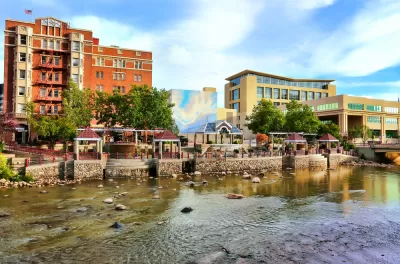As more cities embrace small waterways for public and private development opportunities, experts caution about the risks of trusting existing resources on environmental risk along variable waterways.

Kevin Williams reports for the New York Times of a trend among private developers and public officials toward recognizing the economic development potential of long-neglected creeks and waterways.
The example of Wolf Creek in Trotwood, Ohio opens the article. "A former rail line along the creek has been converted into a bike path, and on warm spring days, cyclists pedal under the shade of sycamores," according to Williams.
Smaller waterways like Wolf Creek offer their own unique challenges when compared to the economic development surrounding the waterfronts along larger rivers, according to the article. Some residents don't realize that new amenities have been added along creeks, for example, but there are also wide swings in the amount of water flowing through small creeks—a variability exacerbated by climate change, according to the article.
The article discusses a variety of challenges and lessons from small cities that have already chosen a creek-oriented approach to economic development. Among the experts cited in the article is Bill Becker, a climate change expert and former Department of Energy official and author of the book, The Creeks Will Rise. In particular, Bill Becker warns that 100-year and 500-year flood maps published by the Federal Emergency Management Agency might not go far enough in defining post-climate change risk.
"Past isn’t prologue anymore," says Becker in the article.
FULL STORY: Creeks, Once Overlooked, Are Now Seen as Assets for Urban Renewal

Planetizen Federal Action Tracker
A weekly monitor of how Trump’s orders and actions are impacting planners and planning in America.

Chicago’s Ghost Rails
Just beneath the surface of the modern city lie the remnants of its expansive early 20th-century streetcar system.

San Antonio and Austin are Fusing Into one Massive Megaregion
The region spanning the two central Texas cities is growing fast, posing challenges for local infrastructure and water supplies.

Since Zion's Shuttles Went Electric “The Smog is Gone”
Visitors to Zion National Park can enjoy the canyon via the nation’s first fully electric park shuttle system.

Trump Distributing DOT Safety Funds at 1/10 Rate of Biden
Funds for Safe Streets and other transportation safety and equity programs are being held up by administrative reviews and conflicts with the Trump administration’s priorities.

German Cities Subsidize Taxis for Women Amid Wave of Violence
Free or low-cost taxi rides can help women navigate cities more safely, but critics say the programs don't address the root causes of violence against women.
Urban Design for Planners 1: Software Tools
This six-course series explores essential urban design concepts using open source software and equips planners with the tools they need to participate fully in the urban design process.
Planning for Universal Design
Learn the tools for implementing Universal Design in planning regulations.
planning NEXT
Appalachian Highlands Housing Partners
Mpact (founded as Rail~Volution)
City of Camden Redevelopment Agency
City of Astoria
City of Portland
City of Laramie




























